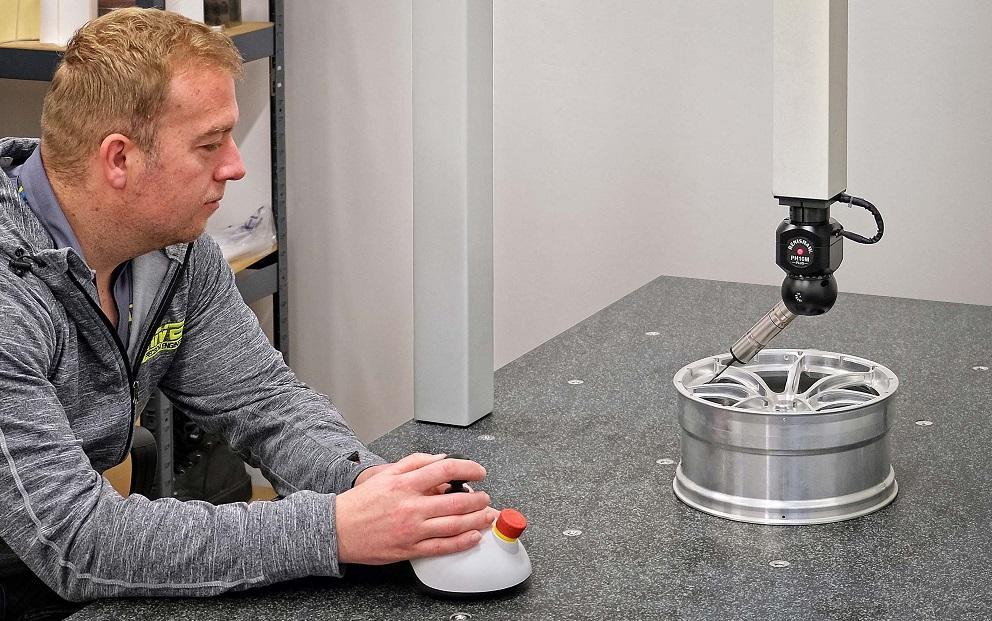- FMA
- The Fabricator
- FABTECH
- Canadian Metalworking
Categories
- Additive Manufacturing
- Aluminum Welding
- Arc Welding
- Assembly and Joining
- Automation and Robotics
- Bending and Forming
- Consumables
- Cutting and Weld Prep
- Electric Vehicles
- En Español
- Finishing
- Hydroforming
- Laser Cutting
- Laser Welding
- Machining
- Manufacturing Software
- Materials Handling
- Metals/Materials
- Oxyfuel Cutting
- Plasma Cutting
- Power Tools
- Punching and Other Holemaking
- Roll Forming
- Safety
- Sawing
- Shearing
- Shop Management
- Testing and Measuring
- Tube and Pipe Fabrication
- Tube and Pipe Production
- Waterjet Cutting
Industry Directory
Webcasts
Podcasts
FAB 40
Advertise
Subscribe
Account Login
Search
Precision engineering firm takes quality control to the next level with CMM
- November 21, 2023
- News Release
- Testing and Measuring
Much of Havant, U.K.-based subcontractor Driven Engineering's turnover comes from Formula One, although the cost cap imposed on racing teams over the past couple of years has reduced it somewhat, leading to a greater focus on aerospace, automotive, and general engineering work.
Owner Ray Harris has historically machined jigs, fixtures, and molds for Formula One teams. Those teams were telling him that to break into the supply of parts for race cars, he would have to improve his component inspection procedures and quality reports.
Calibration company and inspection equipment supplier Mech Metrology & Power Tools, located in nearby Fareham, told Harris about LK Metrology’s coordinate measuring machines. Before investing in a machine, Harris sent a water system for a Formula One car together with the CAD model to LK’s Castle Donington, U.K., factory and opted to view the demonstration online. LK showed two ways of inspecting the component, first by touch-probing to orientate it on the granite and then laser scanning, and secondly using a Renishaw SP25M to probe and touch-scan the part.
ResolutionImpressed with the latter metrology process, Harris ordered an AlteraC 10.7.7 CMM. During its build at the Castle Donington factory, the machine was reduced in height by about 100 mm so that it would fit through the entrance to Driven Engineering's latest factory unit and sit comfortably within a new quality room that was being added.
He also received a single license of PolyWorks Inspector software, which is swappable between the CMM and an articulated arm bought in 2020 when Harris worked in a previous location in Portsmouth.
The step up to CMM metrology immediately brought in extra Formula One work, mainly prismatic machining on three Hermle 5-axis, high-speed machining centers. Parts produced are typically for hydraulic manifolds, as well as the race car front and rear wings and floor. A lot of titanium is processed, plus stainless steel, aluminum, and some engineering plastics.
Unlike jigs and fixtures, which have fairly open tolerances, the latest parts have drawing tolerances down to 25-µm true position, which is impossible to check using the portable arm. The CMM, which can measure very small features, easily completes the inspection tasks.
During programming in PolyWorks, Harris picks the features and profiles he wants to inspect. The software then automatically sequences the points for the most efficient inspection routine, including all axis movements, head rotations, and collision avoidance strategies. Data is captured both by touch-probing discrete points and tactile scanning using an SP25M probe. With the software, programming is completed in as little as 10 minutes, depending on component complexity.
Installation of the CMM has opened a number of different avenues, as availability of advanced metrology makes it easier to win new business, especially tight-tolerance work. Additionally, Harris has bought a Ginetta GT race car to hire out for events and intends to start manufacturing a proprietary range of parts for it, such as uprights, bearing supports, axle extensions, and drive shafts, supported by the higher-level quality control the CMM provides.
subscribe now

The Fabricator is North America's leading magazine for the metal forming and fabricating industry. The magazine delivers the news, technical articles, and case histories that enable fabricators to do their jobs more efficiently. The Fabricator has served the industry since 1970.
start your free subscription- Stay connected from anywhere

Easily access valuable industry resources now with full access to the digital edition of The Fabricator.

Easily access valuable industry resources now with full access to the digital edition of The Welder.

Easily access valuable industry resources now with full access to the digital edition of The Tube and Pipe Journal.
- Podcasting
- Podcast:
- The Fabricator Podcast
- Published:
- 04/16/2024
- Running Time:
- 63:29
In this episode of The Fabricator Podcast, Caleb Chamberlain, co-founder and CEO of OSH Cut, discusses his company’s...
- Trending Articles
Tips for creating sheet metal tubes with perforations

Are two heads better than one in fiber laser cutting?

Supporting the metal fabricating industry through FMA

JM Steel triples capacity for solar energy projects at Pennsylvania facility

Omco Solar opens second Alabama manufacturing facility

- Industry Events
16th Annual Safety Conference
- April 30 - May 1, 2024
- Elgin,
Pipe and Tube Conference
- May 21 - 22, 2024
- Omaha, NE
World-Class Roll Forming Workshop
- June 5 - 6, 2024
- Louisville, KY
Advanced Laser Application Workshop
- June 25 - 27, 2024
- Novi, MI


























